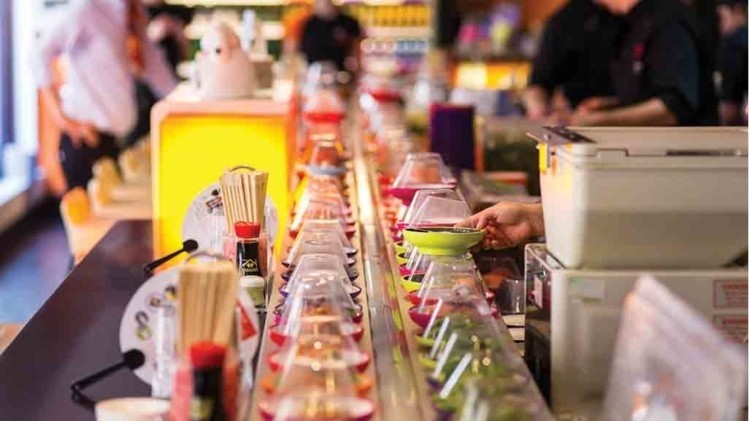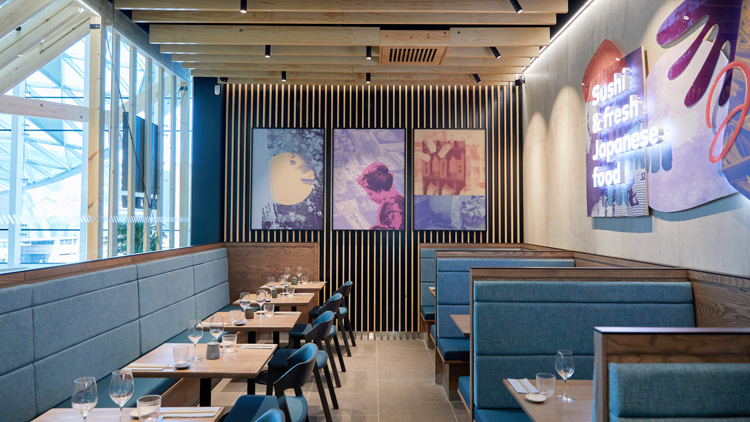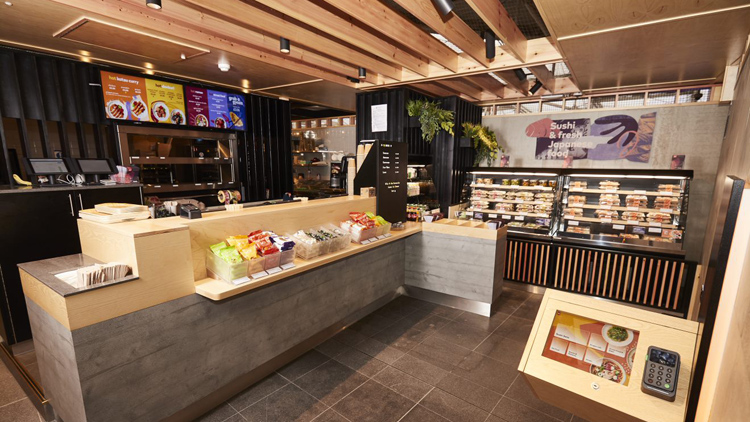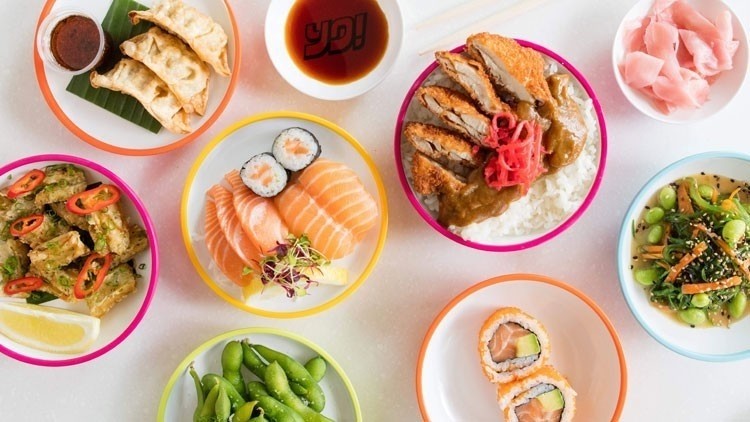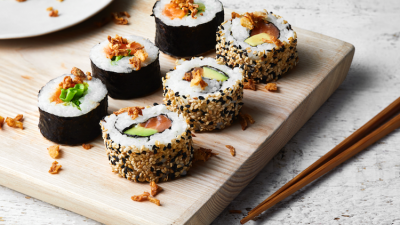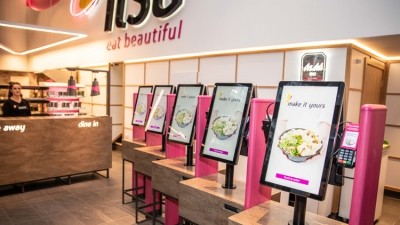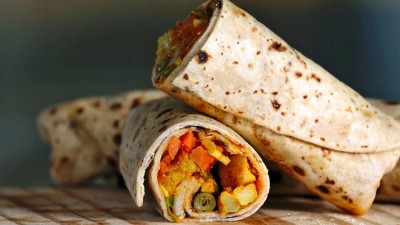NO! Sushi: what YO! is doing next
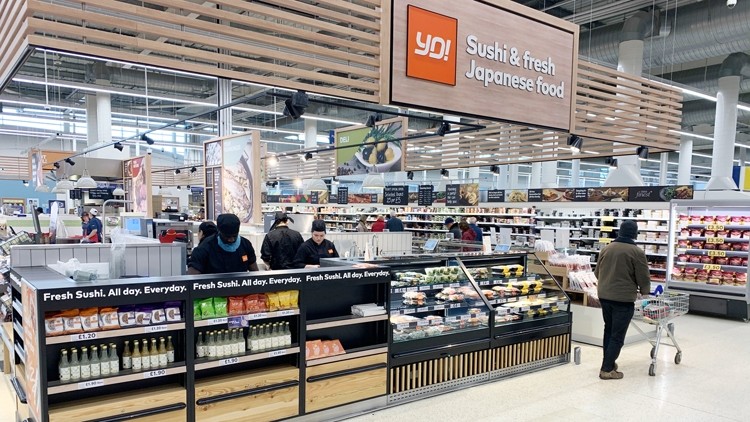
Richard Hodgson’s favourite dish at YO! isn’t even sushi. The group CEO is showing off some of his top items on the new menu and has ordered enough food to cover the entire table, including Korean fried chicken and black cod. “We describe our food as ‘Japanese-ish’, we’re not wedded to one format,” he explains. “But one bad plate of food can stop a customer coming back. You’re only as good as your worst dish.”
We’re sat down at the first YO! Kitchen site in the Westfield London shopping centre, a new concept for the brand, which has seen its famous sushi conveyor belt stripped out in favour of family-friendly booths and tables. The brightly coloured plates that typically revolve around YO! restaurants have been ditched in favour of muted earthenware crockery, and arrive via a human waitress rather than a mechanical loop.
This is just one of the ways Hodgson has sought to reposition YO! since he joined the business in 2017 amid a tough trading period for casual dining. While other longstanding high street restaurant brands have struggled to survive, YO! has evolved from gimmicky restaurant group to one of the largest Japanese food businesses outside Japan.
The company now operates 71 UK restaurants and another 18 under franchise in countries including France, Norway, Australia and the UAE, serving more than seven million people a year. In 2017 YO! bought North America’s Bento Sushi – which provides grab-and-go sushi in more than 900 retail locations – for £59.2m. This was followed by the acquisition of Waitrose sushi supplier Taiko Foods in 2018, and a merger with US kiosk giant Snowfox (more than 700 sushi counters across 50 states) earlier this year. And YO!’s got no plans to stop there.
“Everybody has to change,” shrugs Hodgson, when questioned about the restaurant group’s swerve into retail. “The pressure we’re under as a sector forces us to sit up and take notice. Those who haven’t have failed. Because we’re not tied to one format anymore, we’re more likely to succeed.”
Plenty of fish
The first YO! restaurant opened under its former name YO! Sushi in London’s Soho back in 1997, and was the brainchild of entrepreneur Simon Woodroffe – one of the original stars of the BBC’s Dragon’s Den.
It was not the first kaiten belt restaurant in the UK, that honour went to City favourite Moshi Moshi, which opened in London’s Liverpool Street in 1994, but it was certainly the most eccentric. Launched pre-smoking ban, the debut YO! Sushi featured smoke-extracting ashtrays, automated sushi makers, and a speaking robot drinks trolley (it was retired in 2002). At the time The New York Times likened the restaurant to ‘the set of an MTV video’.
But over the past two decades the concept’s novelty has waned. Sushi is now found in varying qualities everywhere from £300-a-head fine-dining restaurants to the Boots Meal Deal, and rival branded concepts such as Wasabi and Itsu have sprung up on high streets nationwide.
Woodroffe sold his stake in the business in 2008, and the chain was bought by private equity firm Mayfair Equity Partners in 2015. At the time, the group had reported EBITDA of £10.06m, a 7.8% rise on the previous year, but its new owners had bigger plans for the brand.
Enter Hodgson, who joined the business with a background in both restaurants and retail. The Yorkshireman ran PizzaExpress from 2013-2017, overseeing its growth in south-east Asia and China and the successful relaunch of its retail range, and previously spent four years as commercial director at Waitrose, where he signed up Heston Blumenthal and Delia Smith to front advertising campaigns for the premium supermarket chain.
“YO! Sushi was ahead of its time, it embodied true casual dining, but over the years it didn’t really move forward,” he says. “The owners said ‘trading in the UK is tough and it will get tougher before it gets easier’. The plan was to de-risk from the UK and build a global Japanese food business.”
He is clear about where he thinks YO! needed to improve, beginning by dropping the ‘sushi’ moniker from its name. “I found it quite polarising,” he admits. “A lot of people assumed the menu was all raw fish. My massive frustration is that people will buy smoked salmon but are nervous about having sushi. I wanted to demonstrate we sell a lot more than that.”
Loosening its belts
Hodgson has also been keen to trial the removal of the brand’s iconic conveyor belt after observing the seating made it difficult for families or large groups to dine. The format also made it hard to broaden the menu to include more hot food, as it got cold after several rotations. Was he nervous about removing YO!’s signature feature? “People just want healthy, affordable food but are agnostic about how they get it,” he insists.
The first beltless YO! Kitchen restaurants opened in Dublin and at Westfield London in September, and Hodgson says they are already seeing a higher average spend and dwell time than the core YO! restaurants. The broader menu includes small sharing plates such as shishito peppers (£4.80) and Japanese corndogs (£5.60), alongside larger bowls of tonkotsu ramen (£11.20); and robata-grilled sirloin steak served with lotus crisps (£16.40). Prices are considerably higher than the colour-coded bowls on YO! conveyor belts, which range from £2.15-£8.50 depending on their size and contents.
In London’s YO! Kitchen sushi makes up around only 17% of sales and the best-selling item is the YO! fries – chips coated with sriracha and benito flakes. Originally named Furikake fries, Hodgson changed the name following some customer confusion, and sales went ‘through the roof’.
A range of Japanese gins are behind the bar and Asahi is on draught. “Our traditional YO! restaurants tend to do better during the day and not so well at night, but here we can dim the lights and sell more alcohol,” explains Hodgson.
The group has partnered with the app Yumpingo, which allows diners to leave instant feedback on their experience , to develop the concept. If successful, the aim is either to open new sites or convert existing restaurants, though Hodgson believes venues such as airport locations are suited to the belt format.
Grab and go
YO! has also begun mounting a direct challenge to the likes of Wasabi and Itsu with the trial of an express format. In November the group removed the belt from its Manchester Piccadilly restaurant and converted it to the debut standalone YO! To Go site, offering trays of sushi from a fridge, as well as hot food such as chicken katsu curry and yakisoba noodles. A second site under the concept is lined up to open in Bath in February, just over a year after YO! closed its conveyor belt restaurant in the city.
“Pret a Manger and Leon have worked very well in London,” says Hodgson. “Could we be a Japanese version of Leon? We think we can. We’re not arrogant enough to think everything will be successful, but we’re not limited to one thing, which is the problem some other operators are having.”
Hodgson adds YO!’s product is also ideal for the nutritionally-minded ‘Deliveroo generation’, and the company sees it as an area of growth going forward. “Customers are paying full price plus delivery charge, it’s the most expensive way to consume anyone’s product.”
Retail moves
Hodgon’s old employer PizzaExpress sells more pizzas in supermarkets than it does in restaurants, and now YO! is now looking for a similar slice of the retail market.
The group opened its first manned kiosks in two trialTesco Extra sites in 2018, offering made-to-order sushi, sharing platters and pre-prepared dishes such as chicken katsu curry, and is now planning to roll out kiosks to 50 stores nationwide.
A range of YO! branded sauces, seasonings and marinades are already stocked in selected supermarkets, with crisps, snacks and ready meals set to follow.
“The profitability of a typical restaurant is lower than it was four years ago, and there’s not a lot of hope that it’s going to get better,” says Hodgson. “We have to look at where we can generate the best returns: is it opening a new restaurant, or partnering with Tesco? We want to keep building the brand, and retail products go into people’s homes.”
Recent data from analytics platform Kantar found out-of-home sushi sales plunged 31% to £89.4m in the year to 11 August 2019, but Hodgson is confident there is a gap in the market for fresher, more upmarket options.
“People shop more often and in smaller amounts, so supermarkets aren’t getting volume of basket spend,” he explains. “A lot are taking out meat and fish counters and replacing them with theatre through a partner. I think supermarkets will become more like Selfridges, where you walk in and see concessions. It won’t all be Tesco-branded because it’s hard for supermarkets to suggest they’re experts at everything. People are a bit scared of sushi so you need that credibility. We think there are huge opportunities for us in the UK.”
YO! is also making headway in the fitness market and was approached by David Lloyd Clubs to offer sushi in its fridges earlier this year. An initial trial in five gyms expanded quickly to 18 sites and Hodgson says he’d be surprised if David Lloyd didn’t roll it out across its estate in 2020 because of the positive result. “If you spend an hour in the gym, why do you want to then go and have a cheese panini?”
Breaking America
Cracking North America has historically proven difficult for UK casual dining brands – both Carluccio’s and PizzaExpress have tried and failed to make an impact. YO!’s acquisitions means it is now a major player in the region, but it too struggled to make its restaurants succeed across the pond. The group opened its first kaiten belt restaurant under franchise in Washington DC in 2012, before launching a company-owned site in Boston in 2016 and expanding to malls in Florida, New Jersey and New York.
“They didn’t work,” Hodgson says bluntly. “It’s hard to run a restaurant business on the other side of the world when you’re based in London. When I joined, three were still open and I chose to close them straight away.
“As soon as we acquired Bento Sushi that was a better way of cracking North America. Three restaurants in the US is a drop in the ocean, it’s a bit of a waste of time.”
YO! has no further plans to bring conveyor-belt restaurants to the US, but is instead looking to expand its retail sushi into universities – a move it hopes to replicate in the UK.
The company’s latest accounts for the year to November 2018 show UK earnings fell 29% to £5.9m, which it blamed on industry cost inflation, but total sales rose 5% to £88.9m off the back of menu changes and growth in its delivery channel. In that time the worldwide business saw a 47% boost in adjusted earnings, rising from £8.5m to £12.5m.
“I take umbrage to people asking if we’re giving up on the UK,” says Hodgson. “Our growth here is likely to be faster than anywhere else. We opened a restaurant in Watford last year, Ashford before summer 2019 and will open a couple of sites in 2020.”
He adds that he is ‘bored’ of Brexit, and that YO! and its suppliers prepared for an earlier EU departure date several months ago. “My biggest fear is the team. As an industry we are so reliant on foreign workers and it really worries me that people will feel unwelcome. I’m also not sure everybody who voted to leave understands that it could well lead to price rises.”
But Hodgson remains optimistic about the future and hopes the 2020 Tokyo Olympics will spark further interest in YO!’s ‘Japanese-ish’ cuisine.
The company is also looking to expand its global reach and is considering further acquisitions in Europe, South Africa, Asia, Australia and North America.
“We want to build a global business, we’d like to be number one in every market,” says Hodsgon. “We’re agnostic about geography, it’s wherever the right opportunities come up. The only place we probably won’t go is Japan. Every where else is up for grabs.”
This article first appeared in the January 2020 issue of Restaurant magazine, the leading title for the UK's restaurant industry. For more features, comment, interviews and in-depth analysis of the restaurant sector, subscribe to Restaurant magazine here.
